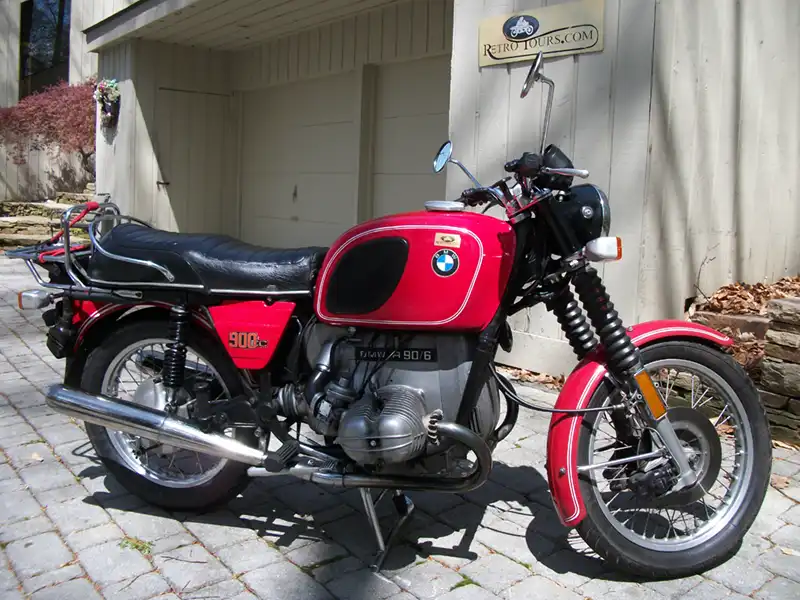 In 1972, I began turning wrenches at BMW Motorcycles of Cambridge, Massachusetts, a European-style urban dealership where I cut my teeth as a professional technician. At the time, my only transportation was an R50/2 – a dangerously slow vehicle in the aggressive city traffic. Until I installed an R75/5 engine and transmission, that is, at which point it became dangerously fast. In those days, the R90S represented for me the prohibitively-expensive but ultimately-cool pinnacle of German motorcycle engineering. “Ya-vohl, ve have vays of making you luff this bike.”
In 1972, I began turning wrenches at BMW Motorcycles of Cambridge, Massachusetts, a European-style urban dealership where I cut my teeth as a professional technician. At the time, my only transportation was an R50/2 – a dangerously slow vehicle in the aggressive city traffic. Until I installed an R75/5 engine and transmission, that is, at which point it became dangerously fast. In those days, the R90S represented for me the prohibitively-expensive but ultimately-cool pinnacle of German motorcycle engineering. “Ya-vohl, ve have vays of making you luff this bike.”
As received, the red R90 now in the RetroTours stable had a Luftmeister fairing, engine guards and saddlebags, and a stock American-spec handlebar. I sold these items off to help finance The Resurrection, and soon fitted shiny new Euro-bars and cables. Fresh tires, rear shocks, wheel bearings and a thorough tune up were next, followed by fitment of a factory-optional steering damper. The missing tool kit was replaced (a pretty major item on an old BMW), and a persistent base-gasket leak was corrected by turning the cylinder base on a lathe. More recently, the machine began to realize its full potential with the installation of dual sparkplugs in the heads, fired by a new electronic ignition which replaced the old breaker points. As a bonus, sometime in the foggy past, the front end had been replaced with the dual-disc setup from an R90S, and the optional factory six-gallon fuel tank fitted. As a whole, this motorcycle is an impressive package, and not far removed from the more collectible, but possibly less practical, R90S.
Everything about the BMW is “different” -- but It works, having been refined from a design originating in 1926. For instance, the bike starts with an electric boot, supplemented by a transverse kick starter – awkward but very useful when an old battery gets weak. The early style four-speed transmission has wide, evenly-spread ratios that leverage the engine’s table-flat torque curve, but shifting must be slow and deliberate – only true finesse is rewarded with clunk-free gear changing. At real-world riding RPM’s, the engine is turbine-smooth, with the perfect primary balance and excellent air cooling more than offsetting the extra width of the boxer engine. The feeling while underway is just heavenly, with a great seat/peg/bar layout that balances the rider against the airflow at travel speed. It’s as though nothing could ever stress this 900cc twin as it eats up miles more like a low-flying classic aircraft than a primitive surface vehicle. Simplified maintenance and great accessibility are also designed into those big horizontal jugs -- it is possible to not only adjust the valves but to remove a connecting rod using only the on-board toolkit, although the BMW’s legendary reliability makes the need unlikely. The stout, shaft-type final drive eliminates chain chores and potential breakage, at the small cost of requiring smooth throttle action in corners.
Competence is the single best word to describe the R90 -- whether logging 600-mile highway days, carving up canyon twisties, or even exploring down a bumpy jeep road. The relaxed engine character complements a fairly amazing suspension system, with a rigid, well-damped front fork and Ikon Dial-a-Ride rear shocks providing wheel travel comparable to motocross bikes of the same era. Compared to its contemporaries, the Beemer just seems to laugh at the bumps, soaking them up and asking for more. No wonder road-dirt-encrusted world travelers have so often chosen the BMW flat twin. Could the rumored superiority complex of many BMW owners be justified?

